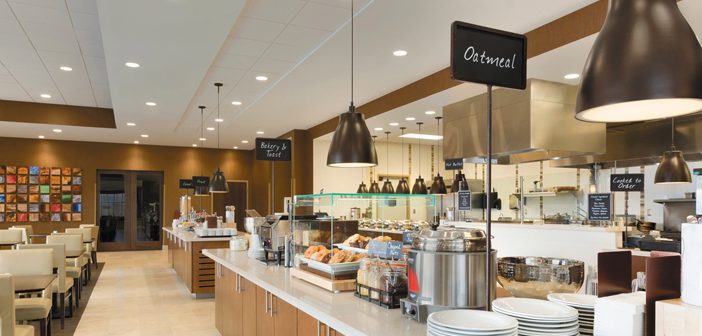Strategically plan and embrace design, F&B and technology investments.
By Alan Roberts
During my 30-plus years in the hospitality industry, I’ve learned that the only constant in the hotel business is change. Design and F&B trends shift quickly, and technology innovations come even faster. But when hotels plan for that change, with careful attention paid to allow for ongoing adjustments for each new development and operational initiative in which they invest, they ensure their ability to stay on the forefront of the ever-evolving demands of travelers and deliver the enhancements that matter most to customers.
Infusing flexibility into hotel design allows hotels to attract, engage and delight both current travelers and the hotel guests of tomorrow. The same holds true for the development of new F&B programs and technology offerings. The most successful hotel brands appreciate how much upfront work is required and put sufficient resources into the thoughtful planning of renovations, updates and “refreshes” of operational offerings aimed at elevating the guest experience.
Reimagining Renovations
Embassy Suites has invested the time and resources to plan renovations for older model hotels that are meaningful to customers, affordable for owners and adaptable over time. Most importantly, planning involves owner collaboration, often the people who know their local markets best because they interact directly with consumers. This local insight is blended with the brand’s overall experience with those aspects of a renovation that provide the greatest returns and enhancement of the overall guest experience.
For example, at Embassy we created the Atrium Refresh, a renovation initiative that transforms the original hotel atriums from traditionally large, open-air spaces filled with live plants, large-scale water features and multiple elevation changes, into scalable social lobbies that invite guests to work, dine and interact in comfortable spaces. Currently, 45 percent of our hotels are undergoing a renovation aimed at this kind of modernization. Between new openings and the high percentage of hotels planning a complete Atrium Refresh by the end of 2019, more than 60 percent of our properties will have a modern and more inviting interior less than six years old.
Homewood Suites’ “Take Flight” renovation program is also designed with travelers and versatility in mind. Upgraded lobby and shared areas offer more interactive ambience and unique spaces. The revitalization initiative is designed to be cost-effective for owners or management companies so they get a solid return on their investment.
In the end, the most successful renovation projects involve careful planning and big thinking that goes beyond the financials to keep guests’ needs top-of-mind.
Turn Technology
into Triumph
Just as careful planning and the flexibility to incorporate guest and owner feedback is critical to modern and meaningful hotel design, it is also essential to selecting the kind of technology that is most valuable to customers.
Today’s hotel guests have embraced the convenience of mobile and digital technology that facilitates everything from booking specific rooms online to checking in and using a digital key on their smartphones. This hard trend, in fact, drives many of the innovations we choose. Feedback from customers tells us that they like the ease and convenience of using our digital check-in with room selection on a mobile device through our app. Since its debut in Summer 2014, the technology has been used more than 26 million times, and is used at a current rate of more than one million times per month.
The popularity of these programs naturally led to further investments in smartphone-focused technology. Guests can now access their rooms through the digital key on the app, which is currently available in 1,200 hotels. We will continue to build on this capability, with an additional 2,500 hotels around the globe expected to offer the service by the end of 2017.
All customers are on a journey: dream, shop, book, pack, arrive, stay, etc. The more we know about that journey and how guests feel at each point along the way, the better we become at minimizing any points of friction, thus enhancing the entire experience. Technology has enabled this valuable feedback loop, and the key to maintaining it is offering guests the technological innovations they want – and some they haven’t even imagined yet.
F&B Foresights
Done right, food and beverage boosts guest satisfaction, repeat business and overall profits. But since tastes, along with guidelines and perceptions of what a healthy meal looks like, are ever-changing, staying ahead of guest F&B preferences and continuously updating dining experiences – whether it be a complimentary breakfast or light bar bites – remains essential. The process of refreshing F&B menus must also be done in a strategic way to continue to delight and surprise guests, while still providing a solid return on investment for owners. Successful brands pull this off by applying some best practices.
Just like a great family meal, preparation is everything. The family chef will learn through trial and error what works well over time. The scale of F&B at a thriving hotel property requires more of a standardized approach – soliciting feedback from guests and conducting additional research. Investing the time to truly listen and adapt to traveler tastes and trends can pay off. Eighty percent of our guests join us every day for complimentary breakfast, providing us with a unique opportunity to both differentiate our offering and build brand loyalty.
Understanding this, in the coming year we will be launching a total redesign of our F&B offerings. This will include the signature complimentary offerings of the evening reception, as well as the made-to-order breakfast that are such core parts of our guest experience. We are re-imagining both to better offer an experience as well as menus reflective of current trends and consumer dining preferences. Similarly, after about five years of a consistent F&B offering at Home2 Suites, we are re-evaluating what we offer and have identified some aspects we feel are due for a change.
A Long Engagement
is a Good Thing
The key to achieving long-term success is accepting that change is part of the very fabric of the hospitality industry. It’s not just about building to meet current demands, because as soon as the last contractor leaves after a major renovation or a refreshed breakfast menu is launched, new trends will emerge and it is time to start again. Instead of this cycle of plan/execute/repeat, a more efficient approach is to design your new properties and major upgrades with future changes in mind. Then the model changes to adapt and adjust again.
This smart and strategic approach not only empowers owners to adapt to changing trends and guest tastes more quickly, it offers a way to meet customer expectations more cost effectively on an ongoing basis. The bottom line is not only financial, but it means building customer loyalty and the kinds of elevated and evolving experiences that engage guests and keeps them coming back for more. ■
Alan Roberts, vice president and global head of Embassy Suites by Hilton, serves as the chief strategist and champion for Embassy Suites. A 30-year veteran of the hospitality industry, Roberts has served in a wide array of capacities, from porter to front office manager, director of sales and general manager, encompassing guest-facing and operational expertise.




